Friday 29 July 2011
Fat-Tailed Dwarf Lemur - Hibernates to Avoid Drought
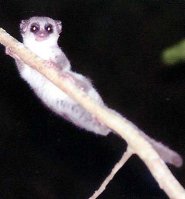
The
Fat-tailed Dwarf Lemur (
Cheirogaleus medius) lives in the Western and Southern
Madagascar areas. The southwest trade winds influence a temperate climate in which the dwarf lemur lives. The areas islands support several lemur varieties including the large lemurs. The fat-tailed dwarf is small in stature and has a fat tail. They are around 6 inches or 15 cm long. The distinctive dark colored rings around their eyes give them the distinctive lemur look. They are a variety of grey and brown colors with a pelage pattern.
How Do They Live?
The lemur spends the majority of the daylight hours in the trees. They sleep in in groups to conserve heat and for protection. They burrow into natural holes in the trees. They are poor jumpers and depend on balance as they move along branches using all four feet. They can travel by tree or land, as long as they do not have to jump. They enjoy a lifespan of fifteen to twenty years in the wild.
What Do They Eat?
They enjoy nibbling on a diet of fruits while up in the trees. At night, the lemurs are their most active. While they sleep in groups, they are solitary hunters. They search out insects and small vertebrates to complete their diet. The weigh around 145 grams or 5 ounces during the rainy season when food is plentiful. They store fat in their tails to sustain them during times of torpor.
How Do They Hibernate?
The fat-tailed dwarf lemurs are the only tropical primate known to hibernate. They do not experience a true hibernation, but rather a state called a torpor. While in this torpor, they go into a trance like state. Their metabolism slows, and they appear to be asleep.
The lemur adapted this state of inactivity to withstand the frequent droughts the plaque the area. They sustain themselves with the fat stored in their tails. They stay in the torpor longer than other animals, sometimes as long as eight months of the year. Their weight can drop as low as 75 grams or 2.5 ounces over the course of a torpor.
How Do They Mate?
The lemurs are monogamous and breed about once every three years. They usually have twins but can have litters as large as four. The gestational period is a short 60 - 65 days. Both parents participate in raising the kids. Studies have shown that if the father is killed or otherwise separated from the family the babies usually die.
Why Are They Endangered?
The two main causes of their endangerment are hunting and habitat destruction. Conservation efforts are aimed at correcting these two causes. They have proven to reproduce well in captivity. In 2008, the IUNC listed them as low risk but of concern for extinction. Birds and snakes are the biggest groups of predators these little lemurs face. Hawks and Boas are known predators.
Picture of Fat-Tailed Dwarf Lemur by Petra Lahann, licensed under
Creative Commons Attribution-Share Alike 2.0 Generic license.
You can help spreading the word about this animal by liking it on facebook
Permanent Link
Tuesday 26 July 2011
Springbok - Peacock of the Savannah

The
Springbok (
Antidorcas marsupialis) is a type of gazelle found in treeless arid grasslands of southeastern Africa which gets its name from its boastful and magnificent jumping display, called pronking or stotting. It can leap 3.5 meters (11.5 feet) vertically and 15 meters (49 feet) horizontally at speeds of 80 kilometers per hour (50 miles per hour). As it falls from the height of its leap, the springbok expands a flap of skin along the rear half of its back, displaying the white fur under its tail in a fan-like shape. This behavior is thought to attract mates through the secretion of pheromones or possibly intimidate predators. The term for this display, pronking, means "to boast or show off" in Afrikaans.
The Springbok's reddish-tan back and white underbelly are separated by a thick stripe of dark drown fur. They are usually between 70 and 87 centimeters (28 to 34 inches) tall and grow horns about 35 centimeters (14 inches) long. The Springbok can be found in the
savannas of northwestern South Africa, throughout the Kalahari Desert in Botswana and Namibia and into southwestern Angola. Well-adapted to its arid habitat, the springbok meets its necessary water intake with the grasses and succulent plants that comprise its diet. As a result, it can survive for years without drinking water, although it will consume water if it can find some. The springbok is hunted primarily by cheetahs, although other animals such as hyenas, lions and leopards occasionally attack the young, old, or sick which are too slow to keep up with the herd.
Springboks travel in herds which are smaller in winter and become larger in summer. However, they are not very social animals in that they groom themselves and rarely touch one another. Females can give birth to a single fawn about every 8 months. Male offspring stay with the female herd until they reach one year of age, at which point they separate into "bachelor" herds. During the reproductive season these herds separate and the males become territorial. Female offspring remain with their mothers until they give birth themselves.
The largest herds of mammals ever witnessed were many kilometers long and consisted of millions of springbok. However, since the springbok has been hunted by man since prehistory, these herds have been greatly diminished. Despite this, the springbok is not considered a threatened or endangered animal and in fact is the only species of antelope with a growing population.
Interesting fact: The Springbok is adopted as a nickname or mascot by South African sports teams, most famously by the national rugby union team.
Picture of the Springbok by Bourlingueurs.com © 2004 Aucun droit réservé.
You can help spreading the word about this animal by liking it on facebook
Permanent Link
Monday 25 July 2011
Northern quoll - Single Parent
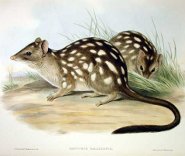
The
Northern quoll (
Dasyurus hallucatus) is a marsupial mammal that is native to
Australia. It was found from southeast Queensland to the northern Western Australia, but is now manly in the Northern Territory's Top End and other areas north of Brisbane. It is a carnivore and eats reptiles, insects, small mammals and soft fruits. It is also a scavenger and seeks road-kill and garbage tins.
On the IUCN Red List of Threatened Species it is considered endangered. This is mainly because of the cane toad. Cane toads were introduced to Australia in 1935 to control a beetle in the sugar cane fields. They have spread right across Australia and where they flourish, the northern quoll declines. Northern Quolls have also declined because they are hunted by feral cats and because of the changed fire patterns.
Northern quolls weight about 0.525 kg (1.155 lbs) as adults. The males are larger than the females. They are between 240 mm (9.45 in) and 350 mm (13.78 in) long, and the tail is from 210 mm (8.27 in) to 310 mm (12.20 in) long. Both males and females reach maturity at 315 days, but that's where the similarity ends. Almost all males mate at one year and die soon after. The female is left to raise the young herself.
She does not have a typical marsupial pouch, but when it is time to breed in late June the area around her nipples enlarges and becomes a flap of skin. The babies, usually six to seven in a litter, live there for eight to ten weeks. Often two or three babies are lost by September.
Also known as the Northern Native Cat, the northern quoll lives mostly in rocky areas. They like eucalyptus forests that are within 150 km from the coast. The animals that live in the rocky areas tend to live longer than the ones that live on the savannas. They can climb well because of small spikes on their hind feet, but they mostly live on the ground. They are nocturnal, but are sometimes found in hollow logs, rock crevices, hollow trees and caves during the day.
The Northern Quoll has a brownish or dark grey body with white spots. It has a long furry tail like a cat and is a prodigious hunter and will consume anything that moves that is small enough for it to manage.
You can help spreading the word about this animal by liking it on facebook
Permanent Link
Friday 22 July 2011
The Amazing Webbed Siamang
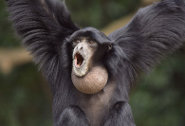
The
Siamang (
Hylobates syndactylus) is a gibbon quite similar in looks to a monkey. However, the Siamangs has white cheeks and no tail. The Siamang differs from all other primates because it is a syndactylus, which means that it has two toes on each foot that are webbed. This webbing is between their second and third toes.
They have shaggy black fur and are the largest and darkest species of gibbon. These gibbons have a hairless pouch on their throat that expands when they are vocalizing. This pouch makes them much louder, able to be heard over three kilometers through the jungle. They have large forearms and are very skillful at using their legs and feet to carry things around. These creatures are quick and agile, able to gracefully travel through the treetops.
Siamangs are a bit larger than other gibbons. They are 74 to 89 cm (29 to 35 inches) tall and about 10 - 14 kg (23 - 30 pounds). They live in rain forests in
Malaysia,
Thailand and the
Indonesian island of Sumatra. They don't touch the ground often, staying instead on the tops of trees. They find on leaves, fruits, flowers, insects and bird eggs. They especially like figs.
Siamangs tend not to do well in captivity, they are much too territorial. The fathers and their male offspring defend their territory together. When the Siamangs reach sexual maturity, generally at eight or nine years of age, and partner up, the mated pair sing to one another, composing a unique song that they use to communicate. They are monogamous animals, and the males are active in caring for their young. They dwell together as a family with one male, one female and their offspring. The adults sleep upright with folded arms and their head between their knees.
The Siamang are considered to be endangered. Due to hunting and a loss of their habitat, the Siamang has decreased greatly in number. Fires or destruction of the rainforests have cleared out much of their home. They are also popular with illegal pet traders. These poachers kill the mothers, who are very protective of their babies, and take the infants. Many of these infants unfortunately die during transport.
Picture of the Siamang by
suneko, licensed under the
Creative Commons Attribution 2.0 Generic license.
You can help spreading the word about this animal by liking it on facebook
Permanent Link
Monday 18 July 2011
The Generuk - Amazing Acrobat
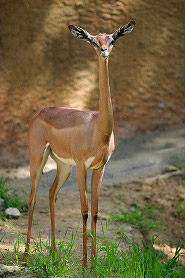
The
Gerenuk (
Litocranius walleri) is nature's little acrobat, able to stand upright on its back legs to graze from higher branches. The name actually means "
giraffe-necked" in the Somali language. An herbivore, it is a member of the gazelle family.
This delicate mammal received its name because of its long neck and legs. The head is small and wedge-shaped with eyes and ears that are large. The tail is tufted and the body has a reddish color in a saddle shape on the back with cream colored legs, and white underpants. The tail is tipped with black hair, making it easily distinguished from other gazelles. The forehead is typically brown with a distinctive blaze on it. The generuk weighs in at about 100 pounds 45 kilograms. They stand roughly three feet, or .9 meters, tall at the shoulder.
The generuk has the unique ability to stand upright in order to pick the select leaves from higher branches. The lumbar vertebrae are stronger than in other animals. It also has stronger lower limbs and wedge shaped hooves. Its acrobatic balance is so refined that it can actually use its front legs to pull higher branches down within dining range.
Generuks prefer the dry habitat of the desert and the bush of the savanna. It also makes its home in the woodland forests in the region. Found in
Kenya,
Tanzania,
Ethiopia and
Somalia it does not require regular supplies of water. It is able to fill its water requirements from the plants it dines on.
Generuks are herbivores and enjoy eating tall bushes, leaves and shoots. They don't dine on grass but do enjoy buds, flowers and fruit of climbing plants. They prefer small groups to large herds and are typically found in groups of 2 to 6 females with one male.
Predators include large cats and wild dogs as well as most other large carnivores native to the area. Specifically, cheetahs, lions and leopards are predators of the generuk. When these animals feel threatened, they stand completely motionless to watch for the danger. Its movable ears are perfect for turning to hear sounds from all around them.
The generuk are not considered endangered, although there is a need to protect the areas in Africa that they are native to. Protecting their habitat can help protect this species as well as countless others.
Picture of the Generuk by Aaron Logan, licensed under
Creative Commons Attribution 1.0 Generic license.
You can help spreading the word about this animal by liking it on facebook
Permanent Link
Friday 15 July 2011
Klipspringer - Incredible Ballerina
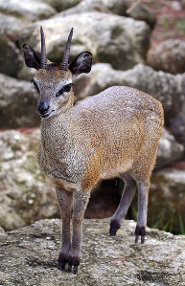
The
klipspringer (
Oreotragus oreotragus) is an amazing little hooved mammal who walks on the tips of its hooves and can race and jump across rocky terrain. Appearing as tiny antelopes, they make their homes on rocky terrains and are known for their amazing agility and grace on the rocks. Incredibly talented at balancing, these little acrobats can bring all four feet into one spot and balance themselves on an area no larger than a silver dollar.
Their technical name is the oreotragus oreotragus and they typically stay very small. They typically only reach 58 cm or 22 inches in height at the shoulder. Their weight will also stay low at a lightweight 18 kg or 40 pounds.
This stocky little animal is extremely powerful and agile. The horns on the male are actually shorter than the ears at only 4 to 6 inches long. The coat if a dark brown flecked throughout with black spots, allowing it to blend perfectly with the rocks it spends so much time on. Evenly spaced eyes are placed above a nose that is wedge-shaped and short.
These delicate looking animals are found through much of southwester Africa from the Cape at the south to Abyssinia and eastern Africa. Within those regions, the toe-prancing light-footed herbivores are commonly found in the kopjes of the savannas. Kopjes are those rocky prominences that jut out of the landscape in the plains. Surrounded by an ocean of grass, the klipspringer is at home on the little islands of rocks.
Unlike most other animals, klipspringers are monogamous. They typically choose a mate and will stay close to that individual throughout life. The males of the species are highly territorial and don’t like to share their terrain. One male will typically claim areas ranging from five to ten acres in size.
The klipspringer is known for some rather rare abilities. When standing, it will bring all four legs together and balance on them in one spot. It is also the only horned ungulate that can lie down with its front legs stretching out together in front of it.
The oreotragus oreotragus has some unique sounds it makes. When issuing an alarm to others it makes a loud whistling sound through the nose. Roaring sounds can be made when they are scared or in distress and the males are known for humming softly when mating.
Kiplingers dine on succulents and other rock plants. Perfectly suited to life on the rocky terrain, they do not require drinking water but can absorb the liquid thy need through their diet of succulents or by licking the morning dew from their rocky homes.
Predators of the Kiplinger include both leopards, hyenas, snakes and
caracals on the ground and eagles from above. Their small size makes them a tempting meal for many carnivores, although their swift feet and affinity for slippery rocks can help keep them out of danger. This little rock dancer is not currently endangered and is considered to be at low-risk.
Picture of the Klipspringer by Munificent, licensed under the
Creative Commons Attribution-Share Alike 3.0 Unported license.
You can help spreading the word about this animal by liking it on facebook
Permanent Link
Thursday 14 July 2011
Pacific Saury - Harbinger of Autumn

The
Pacific saury (
Cololabis saira) is a fish that is found in schools in the North Pacific from Alaska, down to Mexico and across to Japan and Korea. Long and slender, it's considered a member of the needle fish family. The Pacific saury can grow to about 40 cm or 16 inches long and weigh about 180 grams or 6.3 ounces, though it usually grows from 25 to 28 cm or 9.8 to 11 inches. It's happiest in water temperatures from 15 to 18 degrees C, or 59 to 64 degrees F. The saury lives no more than two years. The eggs are fertilized externally and use filaments to attach to each other and other objects that drift in the sea. The parents don't guard the eggs, and many of them are eaten by other animals. However, the Pacific saury is a resilient and prolific fish and its population can still double in a little over a year.
Like many fish, the Pacific saury is darker on its dorsal or topside than it is on its bottom. On top, its color ranges from dark green or blue and its belly is silver with blue spots, a color scheme that might hide them from predators above and hide them from potential prey. Like the tuna, it has tiny finlets near its tail. The Pacific saury lives near the shore as an adult but younger fish live among mats of floating seaweed, very much like young fish in the Sargasso sea half a world away. The saury eats plankton and the eggs and larvae of other fish and is in turn prey for whales, dolphins, sharks and larger fish, and will try to escape them by just skimming the surface of the water.
Pacific saury are an important food fish in Asia, and it's fished much the way anchovies are. Fisherman go out in the dark and shine bright lights from their boats. The fish believe the lights are the moon and swim towards them, where they're caught in nets. In
Japan many foods are considered seasonal and Pacific saury is considered a food served in autumn. It's served grilled with the skin on, with a grated white radish called daikon, with some salt and soy sauce. It's also cooked in aluminum foil with chestnuts, gingko nuts, mushrooms and lemon, or cooked and served with a sauce made of ginger, dashi or soup stock, sake, red miso bean paste and scallion. In the west, Pacific saury is used largely as pet food or fertilizer.
Picture of the Pacific Saury by Miya, licensed under
Creative Commons Attribution-Share Alike 3.0 Unported license.
You can help spreading the word about this animal by liking it on facebook
Permanent Link
Tuesday 12 July 2011
Indian spotted chevrotain - Camouflage Expert
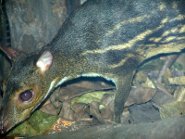
The
Indian spotted chevrotain (
Moschiola meminna), which is primarily found in India, is a member of the Traulidae family. There is also some evidence that the species lives in Nepal as well although this has not been confirmed. It typically weighs around 7 pounds or 3 kilograms and measures approximately 23 inches or 57.5 centimeters in length and has a relatively short tail, about 1 inch or 2.5 centimeters.
The Indian spotted chevrotain lives mostly within semi-evergreen, moist evergreen, and tropical deciduous forests in India. It is known to prefer rocky areas such as grass-covered hillsides and is also found near water sources such as rivers and streams and primarily is a nocturnal animal.
As is the case with the majority of forest creatures, the adult usually remains solitary except during mating season. The animal remains concealed for the majority of the day, typically within rock crevices or in tree hollows. Because of their dappled coloring, they are easily able to camouflage themselves against the leaves on the forest floor. This ability to conceal itself has probably been a leading cause in its ability to maintain the population of the species. The chevrotain is a shy animal that shuns open locations and runs for cover if any sound is heard or an unknown presence approaches.
Their diet primarily consists of herbs, fruits, and other shrubs that have fallen or grow on the floor of the forest. The Indian spotted chevrotain has an average gestation period of 5 months with the females typically giving birth to twins. It has a number of predators including reptiles, birds, and
leopards. Along with the leopard, one of their largest predators is the
human. The chevrotain is widely hunted in the area, through either the use of traps or with dogs and machetes.
Despite the fact that the animal is not without its predators, the chevrotain is not currently listed as a rare or endangered species. The population of the creature is too large as is its range, giving the species the classification of Least Concern. Although little information has been collected regarding the population of the species, there is little evidence that the number of Indian spotted chevrotains will diminish far enough to be classified as Near Threatened. The primary cause for the success of the species is its habitat which has proved to be relatively stable within the range of the species. Despite this positive prognosis for the species, scientists still wish to more thoroughly understand the status of Indian spotted chevrotain populations.
Picture of the Indian spotted chevrotain by Drew Avery, licensed under the
Creative Commons Attribution 2.0 Generic license.
You can help spreading the word about this animal by liking it on facebook
Permanent Link
Monday 11 July 2011
Greater Bulldog Bat - the Fisherman
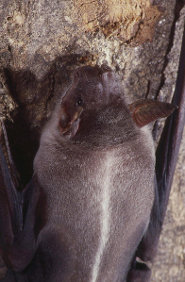
The
Greater bulldog bat (
Noctilio leporinus) is nature's fisherman. Using its amazing echolocation ability, the bat finds fish by detecting ripples in the water made by those fish. Once the bat locates the fish, it dives down, catching the fish in the ample pouch located between its legs, holding on to the catch with its claws. The Greater bulldog bat is also known for emitting a high frequency sound not often heard from bats of this size.
The Greater bulldog bat is one of the larger
bats, with a combined length of about 12.7 cm. Males weigh, on average about 67 grams while the smaller, lighter females weigh in at about 56 grams. The wingspan of the bat extends one meter, tip to tip, though the majority of this wingspan is located in the third digit. Males are easily identified by bright orange fur along the back; the female having dull gray fur along the same area.
This bat can be found in a range that extends from western and eastern
Mexico south to the northern area of
Argentina. Most of the Caribbean islands also can claim to be home to the Greater bulldog bat. While the bat lives in a wide range, it is sparsely populated as its habitat requirements are fairly strict. Non-arid lowlands and major river basins are the preferred habitats of the animal.
The familial structure of the bats is particularly interesting in that the female of the species will remain together in the same location for several years while males will only stay in one area for two reproductive cycles. Females will also hunt and forage in their social group while the males forage on their own in areas separate from the females. During the wet season, the bats hunt for and feed on moths and beetles while, during the dry season, their diet consists of fish, crabs and scorpions. When water ripples made by fish are scarce, the bat will skim along the water, dragging his feet (or raking) for up to 10 meters, trying to catch fish. The areas it rakes are ones in which it has previously had success in hunting.
The Greater bulldog bat is not endangered but is threatened by deforestation like many other species of animal in the region. Those bats that live in
Belize are threatened by water pollution and changing water levels that have restricted their habitat range. In
Guatemala, fish farmers kill the Greater bulldog bats to essentially stop the competition. Happily, for now, the bats are still thriving and should do so for some time to come.
Picture of the Greater Bulldog Bat or Fisherman Bat, Noctilio leporinus (Linnaeus, 1758), adult, captive specimen, originally captured from Puerto Rico, photographed in the United States by Susan Ellis, Bugwood.org. The image is licensed under the
Creative Commons Attribution 3.0 United States license.
You can help spreading the word about this animal by liking it on facebook
Permanent Link
Friday 08 July 2011
Gray Short-tailed Opossum - The Pocket Pet
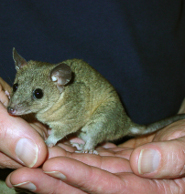
The
Gray short-tailed opossum (
Monodelphis domestica) is a remarkable marsupial because it is one of the only marsupials where the females do not have a pouch. Their newborns just hang on the mother's teats. Due to the inadequacies of the functions of the newborn's immune system, scientists use them for cancer research and general immune system development. Short-tailed opossums are much like humans in the way that they can can develop skin cancer from sunlight alone. They can be found inhabiting or frequenting trees in South America in Bolivia, Brazil, and Paraguay. Measuring 6 - 8 centimeters (2.4-3.1 inches) in length and weighing in at about 60-150 grams, (2.1-5.3 ounces) this cute and furry creature makes for the perfect pocket sized pet for people keeping them.
Gray short-tailed opossums have a diet that mainly consist of insects due to their high need of protein, they will also eat a variety of fruit and vegetable matter. As a pet they are fed fruit, mealworms, and kitten chow. They have opposable toes and on their hind legs they have an opposable big toe that works much like the way a human thumb would work. They also use their tail as another limb. They have smooth pads on their toes and feet that enables them to climb up really smooth surfaces such as glass. Dogs and
birds of prey are the usual predators of the opossum. Fortunately, the gray short-tailed opossum is not on the endangered species list. Short-tailed opossums live about 2 years in the wild and can live up to 3-4 years captive.
Interesting fact: The Gray short-tailed opossum was the first marsupial to have its genome sequenced.
You can help spreading the word about this animal by liking it on facebook
Permanent Link
Monday 04 July 2011
Chinese Goral - Rock-Climber
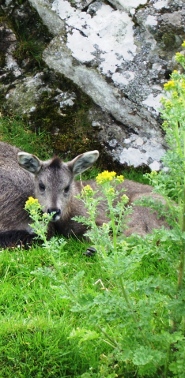
The
Chinese goral (
Naemorhedus caudatus), is a member of the order Artiodactyla and the family bovidae. The animal is related to the common goat and looks somewhat similar. The Chinese goral has many of the same physical features as a goat as they are in the same family.
The goral is about 80-120 cm (31.5-47.2 in) in length with a tail that tops out at about 20 cm (7.9 in). The ears of the goral are quite long, ranging in length from 10-14 cm (3.9-5.5 in). The height is measured at the withers (shoulder blades) rather than the top of the head. The average goral stands about 60 cm (23.6 in) tall and weighs between 22 and 32 kg (48.5 and 70.5 lbs).
With slightly curved horns and very small eyes, the face of the goral is one you won’t soon forget. The fur of the Chinese goral is a mixture of browns, grays and blacks with the female being more diluted in color than their male counterparts. The natural lifespan of the goral is 8-10 years though this is often cut short due to hunting by man. Females give birth to one foal at a time after having carried the foal for six months in its womb.
Chinese gorals are the natural rock-climbers of the world, doing so by instinct rather than training. Ranging from
China to
Russia, the goral can be found in Korea, Manchuria, Burma and Thailand. The animal lives in the high mountain ranges, along vegetated cliffs. Gorals will sometimes break off from their herd to hide in the small crevices that can be found along these mountain cliffs.
Maintaining a diet of grass, leaves and fruits the Chinese goral relies on its keen sense of sight rather than its sense of smell as so many other herding animals do. Because they live in the mountains and on cliffs, they have few enemies. There aren’t many other animals willing to brave rock-climbing to feast on goral.
The Chinese goral is, however, endangered due to
man. Living in herds makes them easy prey for hunters and the habitat of the goral is rapidly being decimated by chopping, cutting and burning. Man has caused the future of the Chinese goral to be uncertain; the goral is listed as ‘critical’.
You can help spreading the word about this animal by liking it on facebook
Permanent Link
 The Fat-tailed Dwarf Lemur (Cheirogaleus medius) lives in the Western and Southern Madagascar areas. The southwest trade winds influence a temperate climate in which the dwarf lemur lives. The areas islands support several lemur varieties including the large lemurs. The fat-tailed dwarf is small in stature and has a fat tail. They are around 6 inches or 15 cm long. The distinctive dark colored rings around their eyes give them the distinctive lemur look. They are a variety of grey and brown colors with a pelage pattern.
The Fat-tailed Dwarf Lemur (Cheirogaleus medius) lives in the Western and Southern Madagascar areas. The southwest trade winds influence a temperate climate in which the dwarf lemur lives. The areas islands support several lemur varieties including the large lemurs. The fat-tailed dwarf is small in stature and has a fat tail. They are around 6 inches or 15 cm long. The distinctive dark colored rings around their eyes give them the distinctive lemur look. They are a variety of grey and brown colors with a pelage pattern. 
 The
The  The
The  The
The  The
The  The
The  The
The  The
The  The
The  The
The  The
The